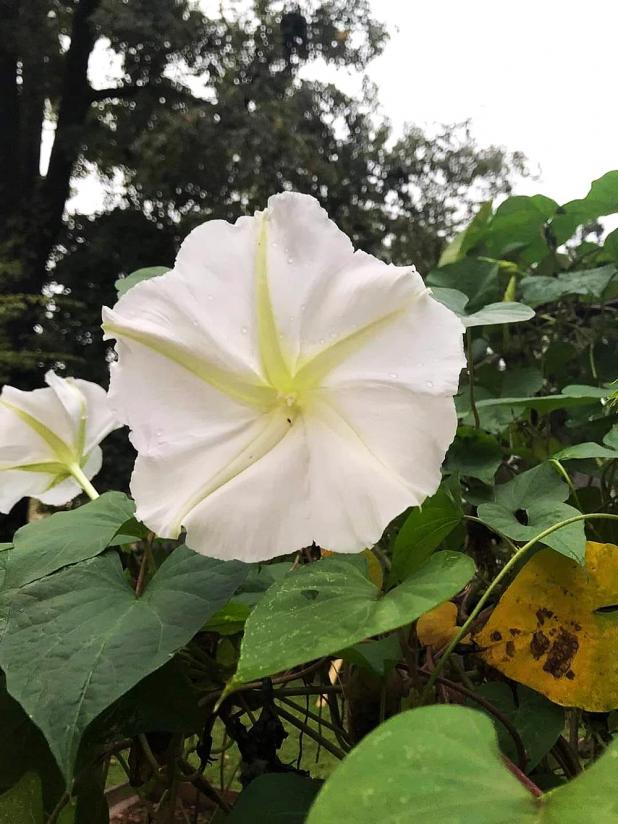
Moonflower (Ipomea alba) is a tropical white morning-glory often planted in moon gardens.
—Christie Russell photo
Get It Growing: Gardening by moonlight
This week’s full moon (June 14) drew many people out to sit in awe of the bright, beautiful moon. It reminded me of moon gardening.
Someone asked me about moon gardening in the past, and I wasn’t sure of what it was. Curious, I did some digging into the subject. Here is what I discovered.
Moon gardens are enjoyed at night and defined by the type of plants they include — typically, plants with white or cool-colored flowers in addition to silver or variegated foliage that can be seen in the reflected light of the moon.
Cool colors such as light blue, bright yellow, chartreuse and lavender in addition to white flowers, and gray and silver foliage can be more easily seen at nighttime in the garden. Moon gardens also can include flowers with heavy evening fragrance as well as light-colored hardscapes and accessories that enhance the garden at night.
The science behind moon gardening is that our eyes have limited vision of colors and contrast in the dark. However, the color white stands out in the darkness and often gives off a glowing light. Also, our senses are naturally heightened after dark to the sights, smells and sounds of the night.
By incorporating a variety of plants, you can enhance your gardens for night enjoyment. Start with selecting plants with white or cool-colored flowers that show up best against a dark background. Incorporate a mix of plants with dark foliage to provide a backdrop.
Some plant suggestions are moonflower (ipomea alba), Serena White angelonia, Infinity White New Guinea impatiens, Japanese painted fern, Ghost painted fern (Athyrium niponicum pictum), Jack Frost brunerra (Brunnera microphylla), Silver Sceptre and Ice Dance Carex morrowii, Silver Carpet Stachys byzantinia, Silver Falls Dichondra argentea, Diamond Frost euphorbia, Lobelia siphilitica, four o’clocks and morning glories. Trees with white or light-colored bark such as river birch (Betula nigra) also can show up well at night and provide some height in the landscape.
In addition to proper plant selection, you can enhance your moon garden by adding light-colored planters and white trellises or lattices that support climbing vines such as fragrant white jasmine. Use light-colored gravel and walking stones for pathways and solar lights to help illuminate them. You can also incorporate lanterns, soft string lights and candles. Choose a site in the landscape that is easily accessible and open for stargazing, allowing moonlight to illuminate the gardens.
For an overall improved ambiance, include elements that engage the senses of sight, smell and sound. Water features that make soothing sounds and reflect moonlight can be a nice addition. You also can attract night creatures such as crickets and frogs by creating natural habitat, adding to sound ambiance.
Sound also can be made by plants such as ornamental grasses or bamboo that gently rustle in the evening breeze. And do not forget fragrant plants.
A moon garden can be enjoyed at any time of day, but they become especially magical at dusk and into the dark of the night. The sights and smells of these plants can continue to be enjoyed at night after the sun sets. The hot days of summer make it less appealing to be in the garden during the heat of the day, but nights are excellent for relaxing outdoors once the sun goes down. You can enhance this experience with a moon garden.
